



Explained: How coal gasification can help India reduce its energy import
Odisha’s Talcher fertiliser plant awarded a contract for starting a coal gasification unit for the production of urea and Ammonia.
- It was part of the government’s initiative to revive closed fertiliser plants belonging to the Fertiliser Corporation of India Limited (FCIL) and the Hindustan Fertilisers Corporation Ltd (HFCL).
- Coal gasification is the process of converting coal into synthesis gas (also called syngas), which is a mixture of hydrogen (H2), carbon monoxide (CO) and carbon dioxide (CO2).
- The syngas have variety of applications such as in the production of electricity and making chemical products, such as fertilisers.
- The coal gasification process holds good potential in the future, with coal being the most abundantly available fossil fuel across the world, and that even low-grade coal can be used in the process.

- Frequent power restrictions.
- Technology mismatch.
- Precarious steam balance.
- Reduce the import of LNG.
- India currently imports 50 to 70 lakh tonnes of urea every year, and that the revival of the units would help increase the availability of domestically produced fertilisers.
- Project would generate direct and indirect employment of around 4,500 people.
- Project’s environment-friendliness would help India in meeting its commitments under the CoP-21 Paris Agreement.
Concerned over rise in prices of Onions, the central Government announced the following key decisions:
- States have been requested to utilize a stock of 35,000 ton available with the Central Government for direct retailing to ease the pressure on prices.
- NAFED, which holds the Central Buffer on behalf of Union Government, has been directed to distribute Onions in Delhi through stores of Safal, Mother dairy, NCCF and its own outlets at a fixed rate of not more than Rs. 24 per kilo.
- The Kharif crop of Onion from Karnataka has already started arriving in the market and this will ease the pressure on supply from Maharashtra as well as prices in adjoining regions.
- MMTC has also been directed to float a tender for import of Onions to meet any short fall in availability.
- The reported export below Minimum Export Price to Bangladesh& Sri Lanka will be immediately stopped and strict action will be initiated against those who are found to be violating this decision of the government.
Source: PIB
The Union Minister of State for Development of North Eastern Region (DoNER) inaugurated the Cane and Bamboo Technology Park-cum-Office Premises of Cane and Bamboo Technology Centre (CBTC) at Burnihat, Assam.
- More than 50% of India’s bamboos are found in this region.
- The market of bamboo is extended all over India.
- There is no dearth of takers or buyers for our products; the only problem is that they do not know what we are producing.
- Will cater to the needs of the industries, entrepreneurs, designers, crafts persons, rural people, teachers, policy makers, technicians and technologists
- The Centre will be identifying and transferring appropriate manufacturing techniques, providing technical assistance, rendering specific services such as, laboratory testing and quality assurance.
- This will itself promote the tangible benefits and will focus for generating village-level cluster and micro-processing units, encouraging and mobilizing SHGs, NGOs to adopt to bamboo culture, attract investment in the bamboo sector in both medium and small sector, create awareness generation, design innovation, new product development, technology infusion and adaptation to the requirement of this country.
About National Bamboo Mission:
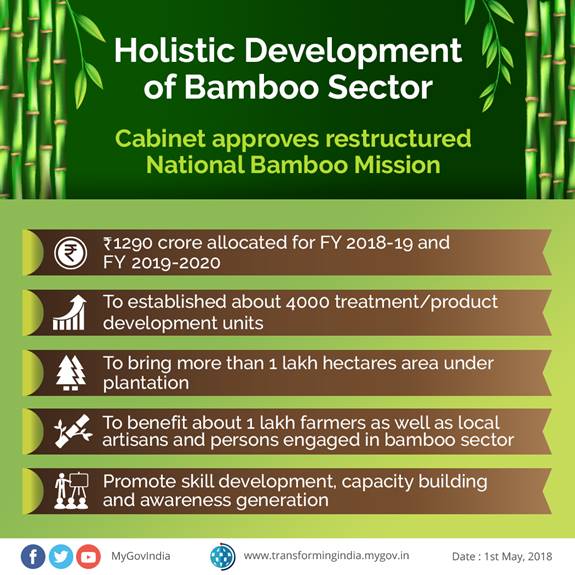
Challenges:
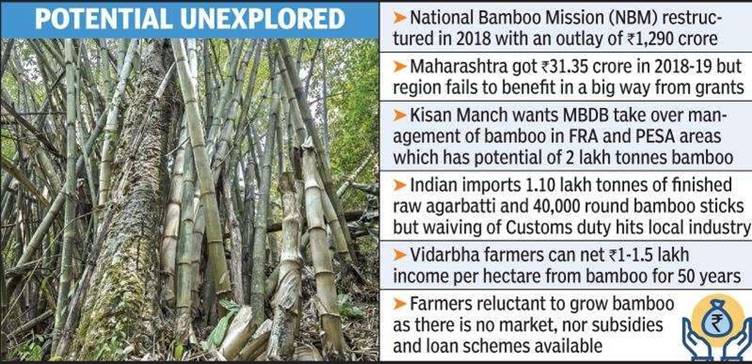
Source: The Pib
Concerns over resource depletion have soared in India because of rising factory output, urbanization and population putting pressure on existing resources.
Union environment ministry has drafted a National Resource Efficiency Policy, aiming to double the recycling rate of key materials to 50% in the next five years and enable upcycling of waste.
- Develop a circular economy.
- This can be achieved by two measures—firstly by recycling the materials, and secondly, by increasing the efficiency of use of these resources.
- Recycling is about industries, which will do it. Resource efficiency is a concept, which needs to be followed across all sectors.
- India is import dependent for critical materials such as molybdenum, copper and nickel.
- This could make it vulnerable to supply shocks, considering rising material consumption, which is up six fold from 1.18 billion tonnes in 1970 to 7 billion tonnes in 2015.
- Linear production and consumption is leading to a lot of wastage in the entire value chain.
- Be it the electronics and telecommunication sector, plastic industry, photovoltaic, battery manufacturing and storage, the future depends on how efficiently the raw materials needed are used, how strategically we procure the resources from outside and ensure efficient use of the available ones to reduce wastage.
- It envisions setting up a National Resource Efficiency Authority, which will help develop resource efficiency strategies for different sectors and adopt them into a three-year action plan.
- The government plans to set up centres to collect scrapped vehicles and carry out the deregistration process, and shredding centres which would segregate materials for recycling.
- As many as 20 official dismantlers would be established across major urban centres by 2020.
- Gradually reduce dependence on virgin materials and enhance re-use of construction and demolition waste.
- There will be emphasis on developing codes and standards for quality of secondary raw materials to ensure confidence in the product.
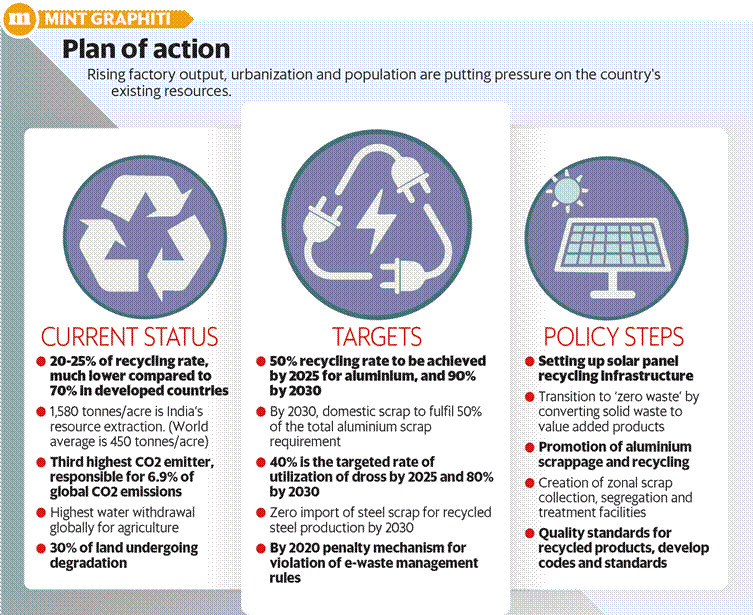
The average global temperature for 2015-2019 is on track to be the warmest of any equivalent period on record, and July 2019 was the hottest month on record globally, a report released ahead of the UN Climate Action Summit 2019 in New York has found.
- The report ‘United in Science’ is a synthesis prepared by the Science Advisory Group of the summit.
- The warmest five-year trend has especially affected large areas of the United States, including Alaska, eastern parts of South America, most of Europe and the Middle East, northern Eurasia, Australia and areas of Africa south of the Sahara.
GLOBAL TEMPERATURE: The average global temperature for 2015-19 is currently estimated to be 1.1°C above pre-industrial (1850-1900) times.
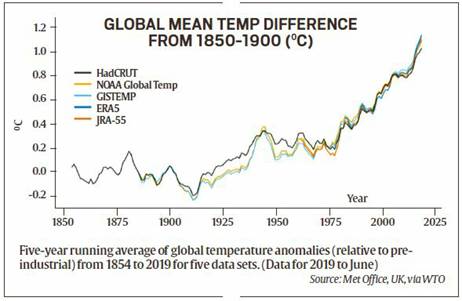
GREENHOUSE GASES: Levels of carbon dioxide, methane and nitrous oxide have reached new highs. The last time Earth’s atmosphere contained 400 parts per million carbon dioxide was about 3-5 million years ago. Carbon dioxide concentrations are on track to reach or even exceed 410 ppm by the end of 2019.
- the report notes that emissions from the US and the European Union have declined over the past decade, while growth in China’s emissions have slowed significantly compared to the 2000s.
- Indian emissions are the fourth highest and are “growing strongly at annual rates in excess of 5%, albeit starting from a much lower base of per capita emissions.
HEATWAVES: The report notes that heatwaves affected all continents and set many new national temperature records. Heat wave that struck the subcontinent in mid-2015 where 2,248 deaths were reported in India, and 1,229 in Pakistan
PRECIPITATION: less precipitation fell in large parts of Europe, south-west and southern Africa, northern North America and a large part of South America, the Indian Monsoon region, and northern and western Australia.
SEA ICE: Arctic summer sea-ice extent has declined at a rate of approximately 12% per decade during 1979-2018. Overall, the amount of ice lost annually from the Antarctic ice sheet increased at least six-fold between 1979 and 2017.
THE Ministry of Defence has formed a High Level Official Committee (HLOC) to consult with defence workers’ federations on the proposed corporatisation of Ordnance Factory Board (OFB), and to make suitable suggestions to the government in this regard.
- To work out ways to safeguard the interests of employees in terms of wages.
- Health facilities and other service matters due to converting the OFB into a public sector entity
- To assess the requirement of budgetary support for salaries of the employees of the OFB
- To assess concerns regarding future orders to the proposed new entity in the view of difficulties being faced in current set up.
- To work out the roadmap for increasing the turnover of new entity from current levels to Rs 30,000 crores.
- To assess viability of some of the factories as public sector entities
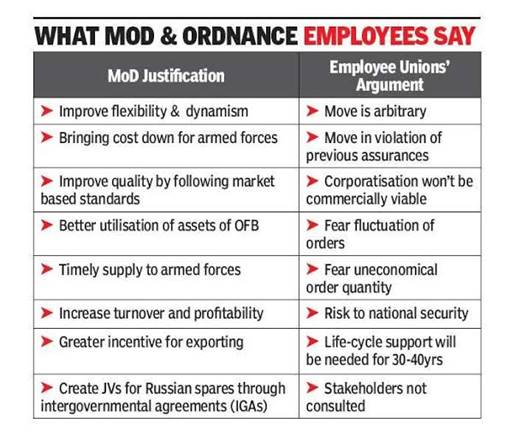

© 2025 iasgyan. All right reserved